A Sitdown with the Library Bandit
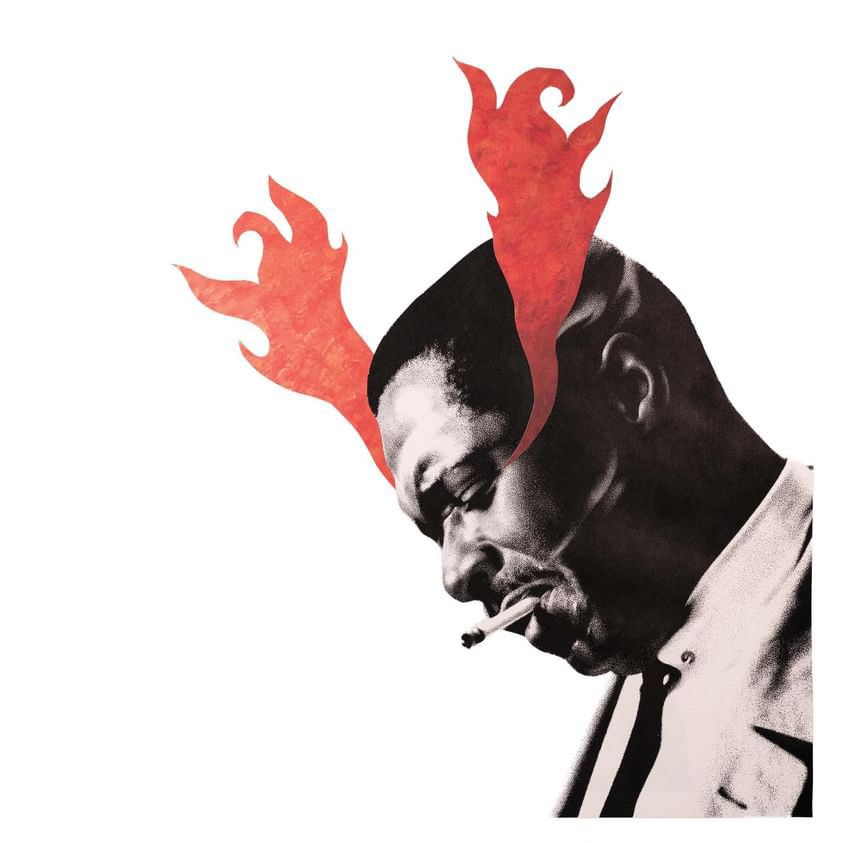
Artloft: So Little Stereo, what’s your actual name?
Little Stereo: Shane Joines
Artloft: It’s nice to have anonymity when you’re doing art eh? Just a bit of separation.
Little Stereo: For sure. I feel like there’s two sides to it. You can kind of create an identity through that right? Like I see MissMe or Billy Woods, the rapper who always has his face blurred in pictures, creating that kind of mystery and separation from the art can definitely be a very useful tool. I’ve debated which way to go with mine, whether to go with a pseudonym or have my name on it. It’s kind of been both. If I’m showing the art then it’s Shane Joines, otherwise…
Artloft: What would be the down side to the moniker?
Little Stereo: Being in the fine art world. I think just going by your actual name is more acceptable there. Quite honestly though I don’t think it matters too much.
Artloft: I mean you’re not doing anything illegal, right?
Little Stereo: No. I wonder about some of the legalities in terms of copyright when it comes to collage, but it’s not something I’m particularly worried about.
Stereo said it’s not the photos you have to worry about as much using other artists’ work.
Little Stereo: There I like to make sure the context is changed. One of the pieces I showed earlier this year in Calgary was just out of a comic and it was just one piece and I added a word with it. But I do think the context was changed enough to amplify it and make it a piece on its own.

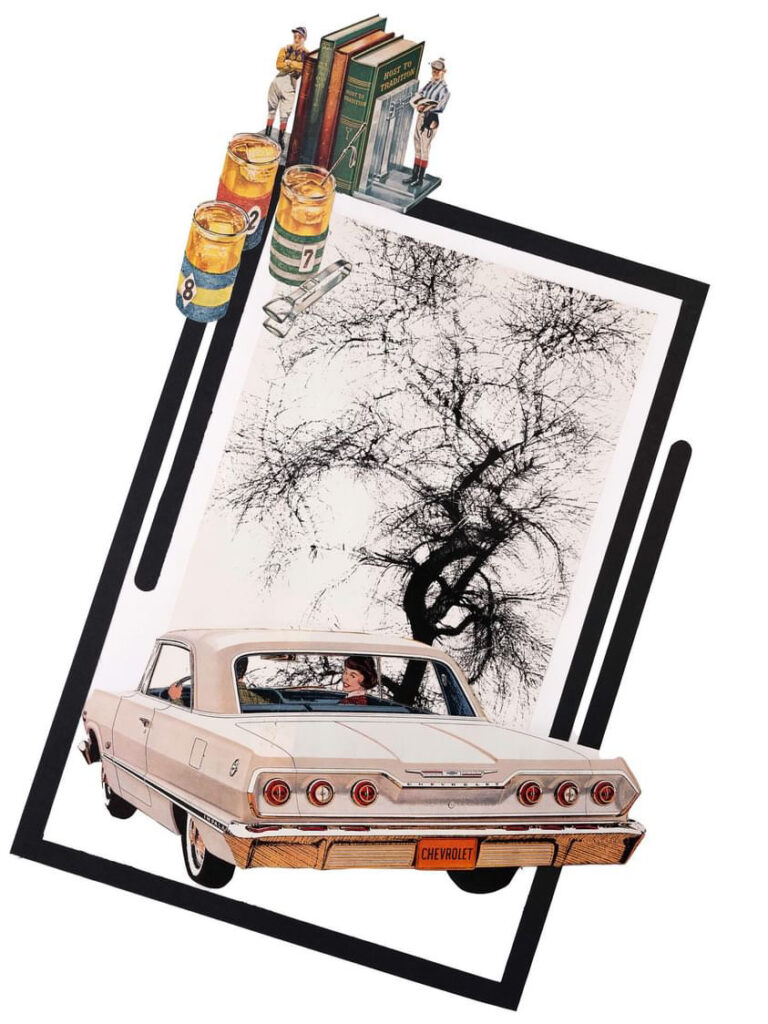
Artloft: I like the simplicity of your work.
Little Stereo: I think my work is best when I distill it to just two pieces and a lot of my work is like that. It’s just two different items that create a new context and a new story.
Artloft: I noticed that. Some collage can get to be too much. Presenting so many juxtaposed images that it becomes meaningless and it’s hard to get a feel for what the artist is trying to say.
Little Stereo: I think a lot of collage is very maximalist. It’s just kind of like, ‘throw it at the canvas’ and it’s too built out. It loses its story.
Artloft: Speaking of stories, where ya from anyway?
Little Stereo: I’m from Alberta, born in Edmonton, lived in Calgary for 15 years and then moved here two years ago.
Artloft: I’ve been told that Edmonton has a pretty good art scene, like more so than Calgary.
Little Stereo: I think that’s probably true, certainly that was the impression growing up. Whether it was the fringe festival or what, but a lot more bands tend to come through there. Music definitely. Calgary has developed more over time with guys like Chad Van Galen. He’s like a lunatic crazy artist. It’s some of the trippiest artwork I’ve ever seen, highly recommend.
Artloft: Where do you go to get your images?
Little Stereo: I definitely have a couple spots. I’m not sure what the name of the book store is on St. Denis but it’s donated books so the books there are all like four dollars and the big ones are like six dollars. So that place is kind of a windfall. I’m always searching book stores when I go travelling because books are where I take most of my stuff.
Artloft: Is there a certain type of book that you can tell right away will be full of good images?
Little Stereo: You get them from different places but the photography section will be the mainstay.
Design books are also a favourite of the Calgarian collagist.
Little Stereo: The other day I picked up a Deus ex machina of a motorbike company. They had one of their lookbooks, and it was cheap as hell. What I look for is even the type of paper. I far prefer matte when it comes to life in general versus glossy. The texture of the pages matter.
Artloft: That matters for photocopying or cropping?
Little Stereo: It matters for gluing.
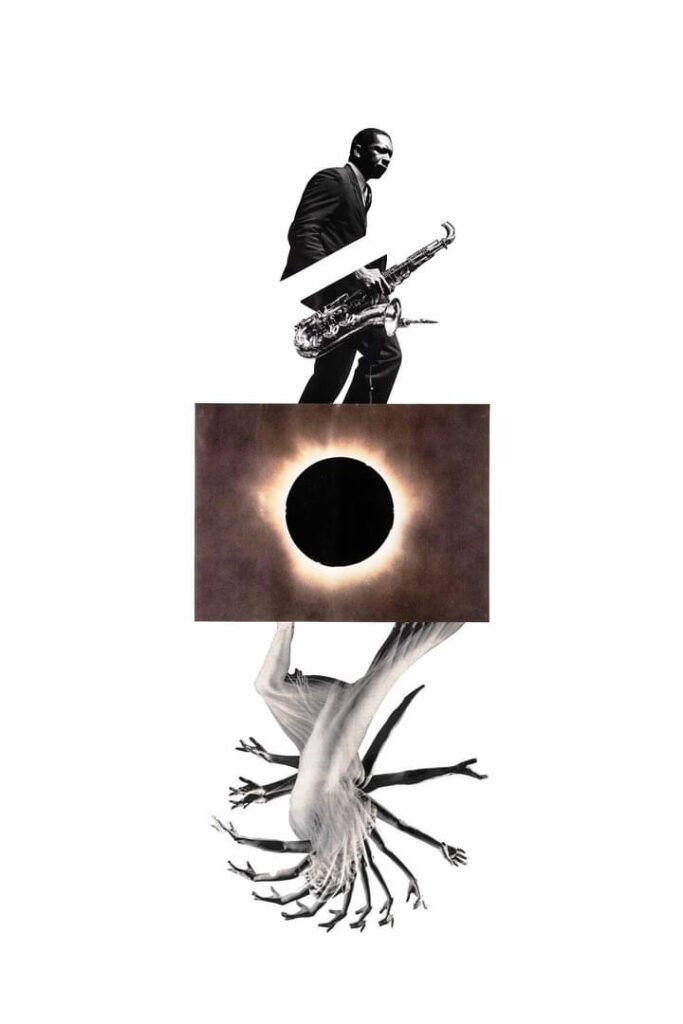
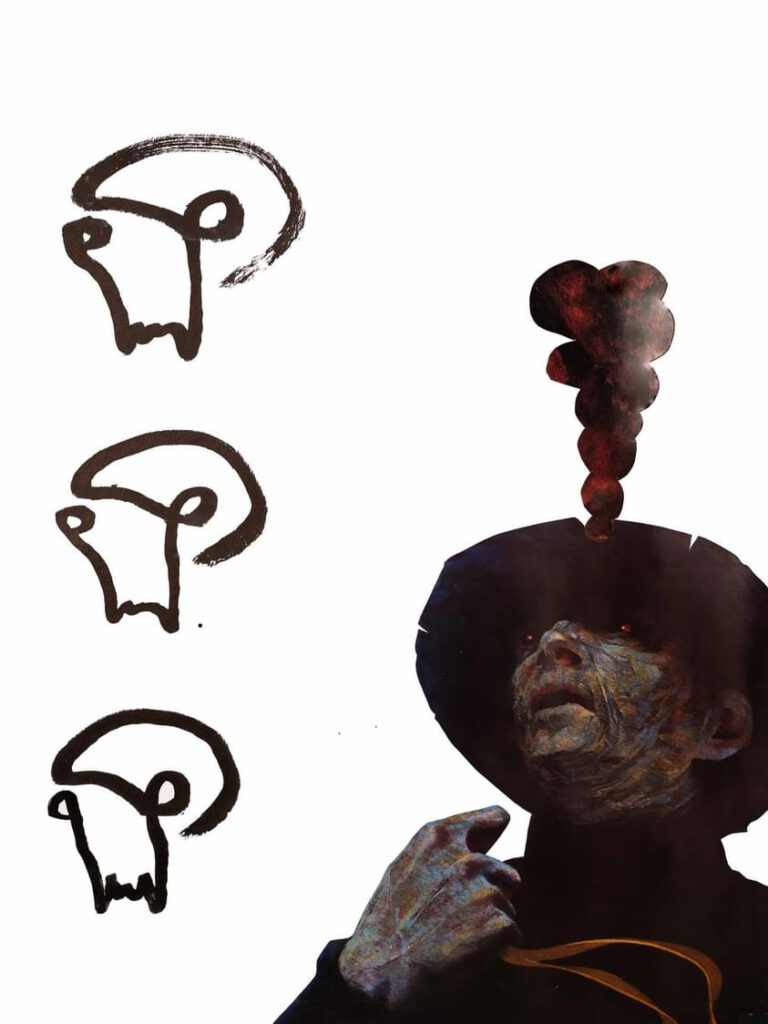
Artloft: Because your work is all analog.
Little Stereo: Yeah, there is no digital at all.
Artloft: Well that’s certainly a credit to you because some of them look like they could be digital. It’s clean enough to look like it could be photoshopped, but the analog is more impressive.
Little Stereo: Thanks yeah, but I keep it strictly analog.
Artloft: That’s probably half the fun of it eh, just not being in front of a screen. I’ve started dabbling in collage a bit myself recently, not anything I would put out because it’s not that good. But I find the act itself to be quite therapeutic, the cutting or the tearing and moving the pieces around.
Little Stereo: It can definitely be meditative in a way, throw on some music. You get into the cutting and I like the assemblage as well. I live in a loft and I’ll just lay the stuff out on the floor and let it percolate for a few days. Some of the stuff is almost instant now, you just find those two pieces that fit, but a lot of it kind of develops and I’ll let it develop over time.
Artloft: It’s funny how you can think there’s nothing and then you move one piece around and then it just takes on a life of its own. I was just about to throw out a calendar from last year, you know one of those free nature scenes calendars but then I thought, ‘I’ll try and do something with this’ because it’ll be a challenge. It’ll probably require getting a little more abstract.
Little Stereo: Yeah, my work is starting to get more abstract now in how I’m cutting things up. I will still use a lot of literal pieces because it’s working with those textures that defines where the work goes. It finds themes through the material.





Little Stereo: Scalpel, like a precision knife.
Artloft: Is there somebody there that hands it to you?
Little Stereo: Haha, no not quite. But Yeah I just use a board and precision blade and then glue sticks.
Artloft: We talking, regular, run of the mill Dollarama glue sticks here?
Little Stereo: Yeah. I’m sure there is probably a debate in collage world about which types of glue to use. But I like things to sort of develop so when I’m putting things down I still move them around a little and that gives you the possibility to do that. Whereas, liquid cemented won’t. So for the kind of work I do I prefer the glue stick. There would be advantages to the liquid cement because it will glue down to the paper better but then it depends on the kind of paper too. I guess this is the boring part of the conversation, haha.
Artloft: It’s the minutiae of the culture.
Little Stereo: Some papers glue better but some don’t absorb the glue so well and then it’s hard to flatten them out after. Thick, glossy papers are definitely difficult to work with.
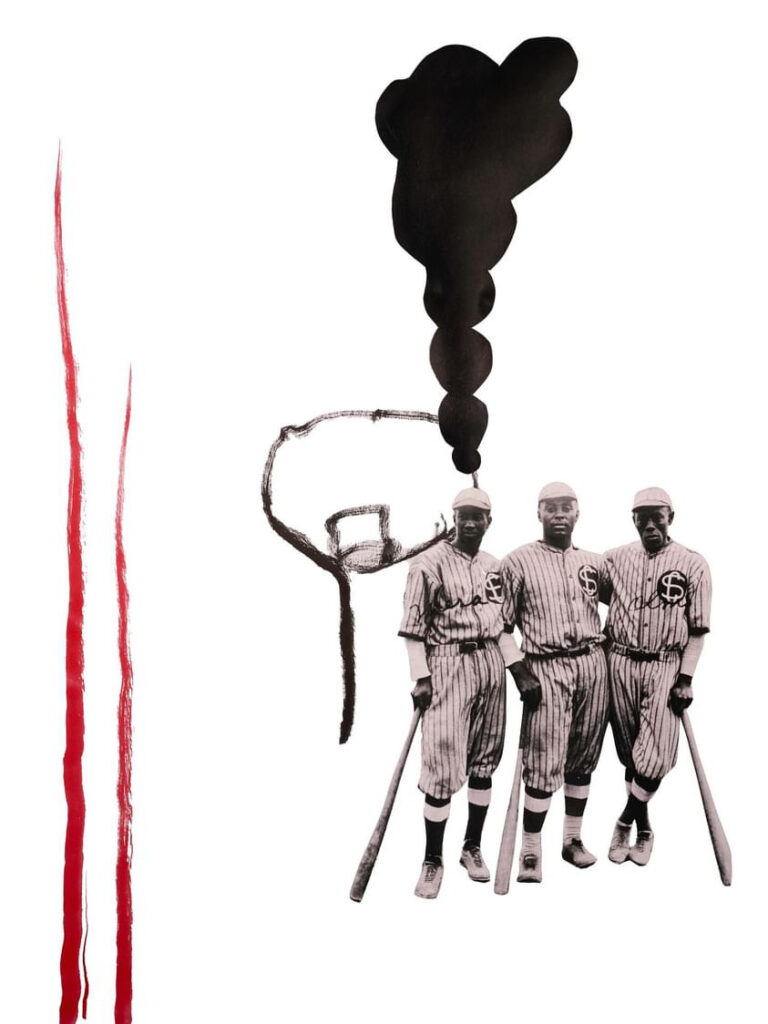


Artloft: Is there something you’re ever trying to say with a collage? You say you like to let it percolate, but maybe something happens and then you’re in a certain type of mood and then you’re like “I want to say this?” Or is it more the image that directs you?
Little Stereo: It changes. Again, the material develop their own themes. But I’ve made a few pieces about what was sort of talking to me then. I made some about the residential schools and went that direction with a few pieces. The series that I brought to show you today are all in reference to Blue Note Records. Jazz is definitely a theme of mine that I return to. Sometimes though I’m just trying to make cool shit.
Artloft: And you’re pretty new to this, about a year or so you told me before? Were you doing any other kinds of visual arts prior?
Little Stereo: I do photography a bit.
Artloft: Do you ever use any of your own photos for collage?
Little Stereo: I haven’t yet but it’s definitely a direction I’d like to go. I did one where I used a photo of me that a friend took and sent to me but it’s definitely a way I could see myself going.
Artloft: It would add a whole other layer to it if the images were taken by you as well. What first drew you into collage?
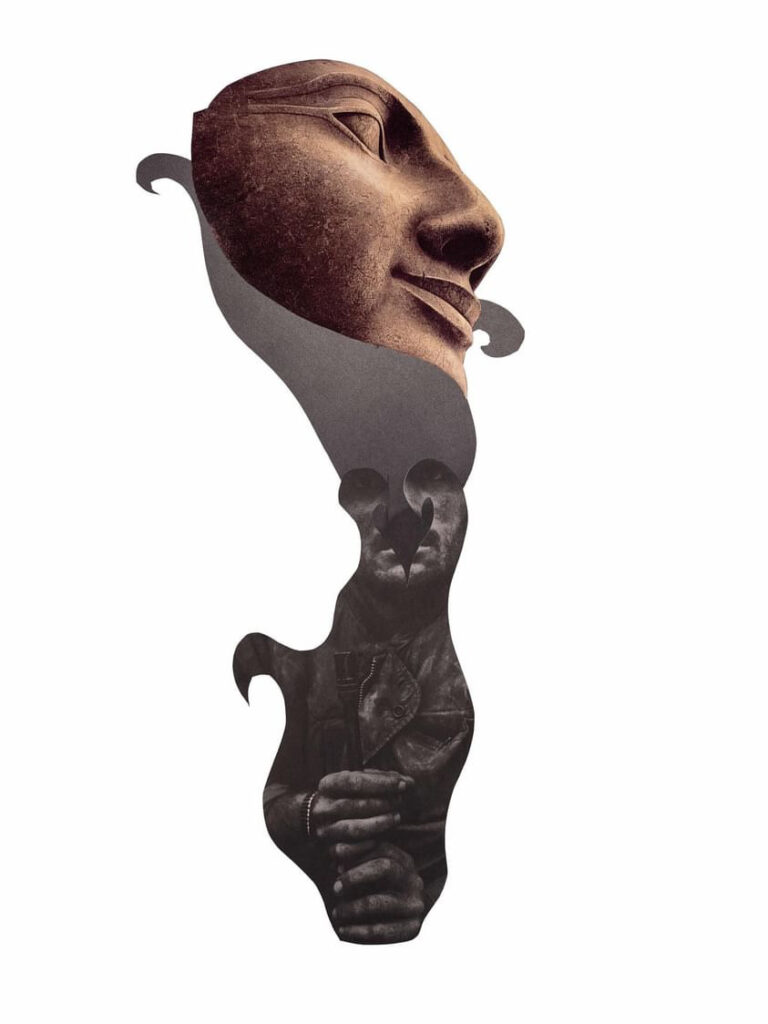


Little Stereo: Part of it is just not being trained in the arts. It’s accessible, being able to just cut and glue. It is sort of the everyman’s visual art in a way. First of all you have something to work from already and there is more room for, maybe not error, but just more room in general. Oil paints for example require a bit of knowledge beforehand.
Stereo said he’s frightened by the notion of painting outright. While he’s begun incorporating ink work onto some of his pieces, painting “seems like a mountain to climb.” He said the same goes for illustration. Something he once enjoyed as a kid would take years to hone to become great.
Little Stereo: I just don’t have that kind of time in my life. An ex of mine was a realist/surrealist painter and the amount of hours that I know she had to put in was kind of staggering.
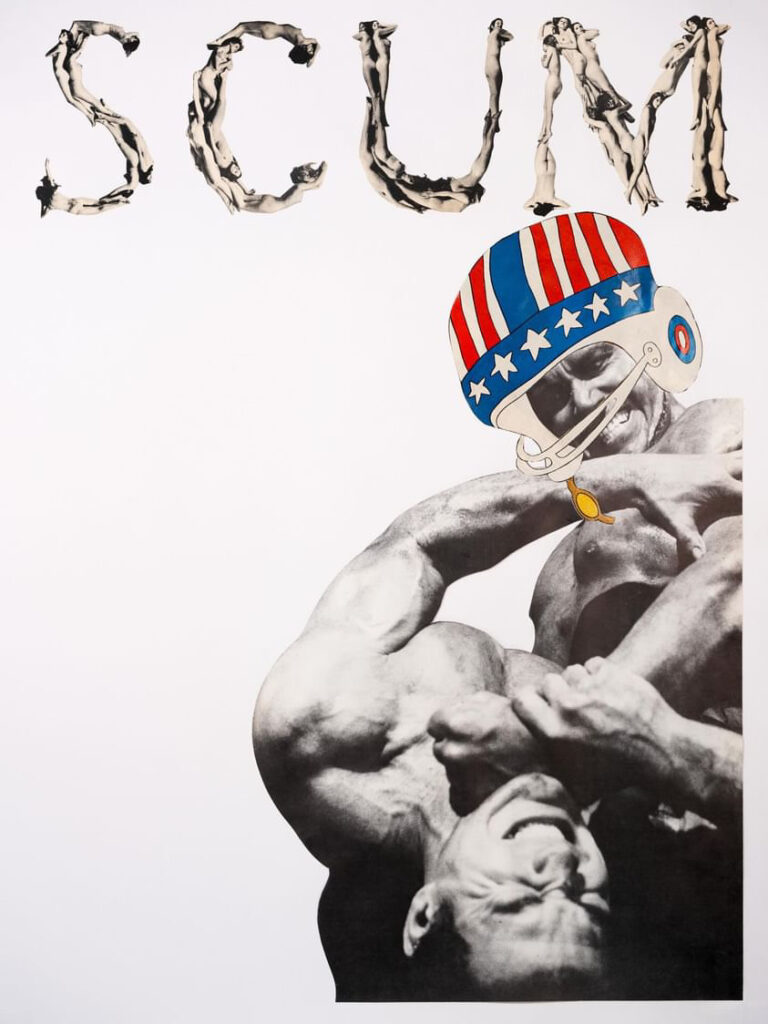
Artloft: With collage, surrealism is kind of built into it. The viewer knows immediately that what they’re looking at isn’t real. They know that they are looking at images that shouldn’t be together.
Little Stereo: Right, that’s an interesting point. It takes it out of the realm of the literal. That’s why I keep coming back to the word ‘story’ because I think that collage is sort of the beginning of a story. Not everybody sees the same thing in a piece of art. That’s a really cool part of where the art comes in, especially with collage art. Storytelling, and branching off of a story by juxtaposing two different images and changing the context will definitely lead people off into different directions. And that’s what I really appreciate about it. It’s the jumping off point.
Artloft: Where do you typically get your material?
Little Stereo: I probably shouldn’t say this but I’ll sometimes go to libraries and take, like a couple pages.
Artloft: What? You take a couple pages out and then just slide ‘em back on the shelf?
Little Stereo: Haha, yeah. You go to these university libraries where these books are buried and probably never seen again you know.
Artloft: That’s a felony offence my man.
Little Stereo: Yeah, I don’t know if I should but…it’s something I do.
Artloft: Well, if they send you to jail for that, you’re not going to do too well in the yard. If you tell the other inmates you’re in for stealing pages out of books at the library, they’re gonna give you a hard time in there.
Little Stereo: I think at worst I’ll just be banned from the library.
Artloft: Do you ever use old ads? I find that to be such a rich source of visual art in general.
Little Stereo: Definitely. I dove into a lot of LIFE Magazine.
.


Artloft: Are there certain collagists you follow for inspiration?
Little Stereo: I really like Drea Collage in town. She’s a local that does really cool work that has inspired where some of mine has gone. Another woman in town, Marie Pere Lopes does some pretty cool stuff. A big inspiration of mine would also be Nicola Craven, the producer.
Stereo told me he’s a producer and rapper currently hanging his hat in the neighbourhood St. Henri. Known for his drumless beats, Craven’s blending of succinct loops together had an influence on how Stereo began to perceive collage work, prompting him to take a similar approach.
Artloft: Yeah, you almost don’t want the viewer to know where the images attach, they will to some degree, but the less glaring it is, the better.
Little Stereo: You want it to form something new. So that it’s its own thing and one that is whole.
Artloft: Your last name is Joines, seems kind of funny for a collage artist. Pretty serendipitous. Do you have a piece that is your magnum opus to date?
Little Stereo: Perhaps, I just made one called John Coltrane vs. Sheeva the Destroyer that I think kind of defines where I’ve gone with my work. I think this Blue Note stuff is some of my best work. There is still room for a lot of improvement. I think a lot of the work has changed so it’s funny to say ‘improve’ because it’s gotten a lot more abstract. I’ve used a lot of different cutting techniques but you get more familiar with the process. Like the types of paper matter to me now whereas they didn’t before.
Artloft: Because it will cut better?
Little Stereo: More glue better. I photoscan all the work for posterity but some pieces definitely deteriorate over time.
Artloft: What is the best paper?
Little Stereo: The stuff I work with usually is mixed media paper. I work on a pretty decent size, it’s either 18×24 or 12×18. I find a lot of collage artists work pretty small but I’m happy working a larger size.
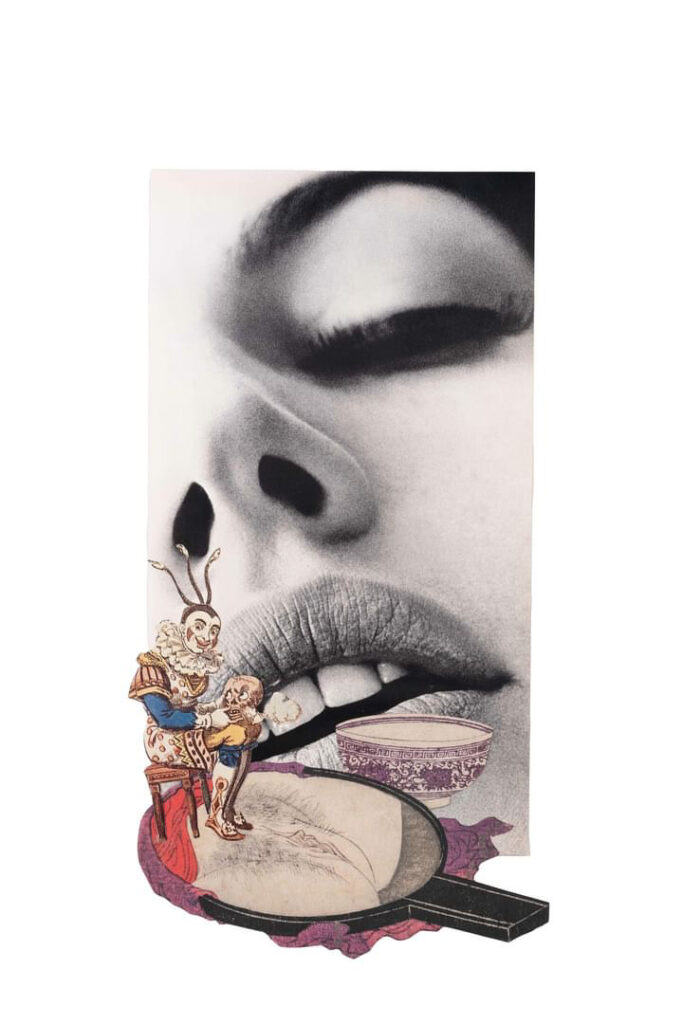
Artloft: Have you done any exhibitions?
Little Stereo: I have done a few yeah. I did one here in Montreal at Vice & Versa in March and I did one last year in Calgary, a show in Amsterdam.
Artloft: Man, you’re movin’ and shakin’ for somebody that’s new. A lotta people will take 10 years before they will put their work out publicly.
Little Stereo: I have been fortunate. I did another small show here last year at Work In Progress as well. I’m gonna bring this work around do BBAM Gallery.
He said that one major challenge starting as an artist is that you don’t have those connections that art school people tend to develop over the years. However, friends have been accrued since making prints. It’s not uncommon that the same people who have the printers also have access to decent connections, noted Stereo.
Little Stereo: There is a lot of networking in the art world, which isn’t my forte. I’m a pretty introverted person.
Artloft: Not uncommon for visual artists, I’d say.
Little Stereo: If not introverted, I just hate the buying and selling process. I’m not a fan of commerce per se.
Artloft: A lot of people get into that world to avoid that world altogether I think.
Little Stereo: But it’s funny how quickly it rears its head though, that’s what I’ve noticed getting into this world. If you’re going to be a full-time artist, it’s obviously part of it. It happens right away, like how much will I charge for this piece?
Artloft: And can I write off stolen images from the library.
Little Stereo: Haha, yeah I’m definitely keeping all my receipts.
Artloft: Are you done with the Blue Note series now?
Little Stereo: Yeah, because the gist of it came from one Blue Note book, and then I kind of expanded from there. There are a few Eric Dolphy pieces in there, he’s an artist I really like. So I took some pictures of him and then added some abstract pieces to sort of capture his essence.
Artloft: Is there any sort of message behind the series, or just celebrating your love for jazz?
Little Stereo: Yeah that’s it. Just taking artists I love and then trying to visually capture a bit of the essence of the artist.
Artloft: When you complete a series, are you raring to go for the next thing or is there a bit of a high off that where you feel like taking a bit of time off?
Little Stereo: There’s little lulls but it seems to pick up again pretty quick. I’m not gonna lie, once I’ve done work that I’m kinda keyed on it feels like, ‘do I have anything left?’
For the time being he has plenty of pieces cut out and ready to use, remaining on the hunt for new books that may lead him in a different direction. Once enough of that is gathered, “things start coming around again.”
Photoscanning may be the most daunting and tedious part of the work, taking some time. Stereo must properly light the piece, then shoot it on camera and before making some final editing touches on the computer. “It’s a bit of a process,” noted Stereo but one which gives him time to recharge the battery. “I do have the feeling that after every time I’m done some work that I’m proud of I’m like, ‘is this gonna run out?”” he said with a chuckle.
Little Stereo: “But I think my works’ changed a lot over the year and gone a lot of different directions so I do think if that keeps happening I’ll have plenty more room to explore.”
Artloft: Any inklings as to what the next series would be or where you’re leaning towards thematically?
Little Stereo: No, not sure yet. I just finished this week. I did do a couple pieces of some magic book that I was working out of. Yeah, copped a couple pieces out of there. But am I finished the Blue Note? I’m not quite sure, I did just do another one to add on yesterday…so…yeah, not to sure where I’ll go next after that but we’ll figure it out.
Artloft: Is there a collage community?
Little Stereo: Yeah, there is a bit. Drea Collage puts on these collage night.
Collage Night Club is a semi-regular event often at Vice & Versa which invites people to come out and get collages going. No reservations required. Little Stereo has been known to attend.
Little Stereo: It’s been pretty successful, it can get pretty packed in there. People bring in magazines and I brought in a bunch of books to donate last time.
Artloft: So it’s more of a Robin Hood thing that you’ve got going on?
Little Stereo: Yeah, give a little back.
We shared a good laugh there.
On the matter of digital collage, Stereo said he can appreciate it, citing Moon Patrol as an example. But since he’s started doing the analog work he finds himself caring less about it.
Little Stereo: I would never say never, but you start getting that baked-in sense of being a purist. It is nice to be doing something analog because it feels more real. You know we’re getting to questions about AI work and I think basically it comes down to a choice of whether you’re supporting AI or not. For me, I completely dismiss it. It’s bothersome to me. I’m sure we’ll get to the point where it becomes unrecognizable whether its AI or not but…
Artloft: It’s certainly recognizable at the moment. It’s kinda offputting, it all looks the same. I know it’s in its preliminary stages but you couldn’t have a more antithetical quagmire, I mean artificial is in the name. We think of art as a form of pure human expression. It’s a very odd thing to think ‘computers will take care of that now, we don’t need to express ourselves anymore.’
Little Stereo: So it comes down to a choice of choosing to support artists and follow artists. So in that same vein, yeah I definitely do have a kind of negative attitude toward digital collage.
Collage has always been juicy to me, it’s immediate but it’s also a bit of a challenge because you’re trying to figure out what exactly is happening. It goes from jarring to perplexing, giving the viewer somewhat of a puzzling experience.
Little Stereo: It’s kinda built into the idea of juxtaposition, surprise. And surprise is something that keeps human beings entertained in a large sense.
